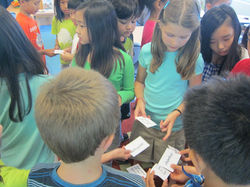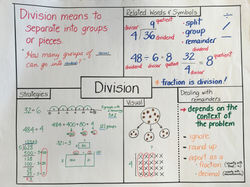

I LOVE MATH!
If only I learned math this way when I was a kid...
 Personal connectionsIs your backpack too heavy? How can you find out? |  TransdisciplinaryMaths, art, language, science and skills. Writing reflections on maths learning outcomes and also considering the approaches to learning: collaboration skills, communication skills, self-management skills, thinking skills and social skills. |  EstimationReal world application. What is the volume of Ms Lau's tupperware containers? Which one would be the best fit for our (fake food) leftovers? |
|---|---|---|
 Fair teamsHow can we figure out fair teams for the track and field long jump event? |  ManipulativesAlways always always begin with the concrete, before moving to the representational and abstract. Students should be using manipulatives all the way through Gr6. |  Sharing strategiesHow can the same problem be solved differently? Which strategy is most efficient? |
 STEAMInterdisciplinary learning with math in science. How does the speed of the water flow affect the amount of erosion in our stream tables? |  Games (I)Let's get up and moving! Different ways to review and learn the same content. |  Games (II)Games are great for practice. Practice makes permanent. Makes things fun! |
 Engineering & DesignAnother example of interdisciplinary skills. How can we build the tallest tower? |  Explain your thinkingAn answer is not enough...we need to see the thinking behind it, too. |  Critical thinkingOpen questions require critical thinking skills. How do you know? |
 FluencyFluency is NOT speed. Fluency is accuracy, efficiency and flexibility. |  Constructing understandingStudents need to explore different ways to help them construct their own understanding of concepts. |  Place mats |

Math Menus
One of the ways I like to differentiate in maths is to use math menus. I have used these both in class as well as for home learning (homewor). Students get to choose activities and practice quesitons that are at their 'just right' readiness level. There is usually a mix of word probelms and quesitons from previous learning for review. Some are open quesitons and I also like to include modality choices including things like podcasts, seesaw recordings, student designed anchor charts, videos and song.

Real Projects
What's the point of learning maths if we can't use it? Enter projects! Here is an example of a project I gave students. With a given budget, they helped me figure out what to get to decorate my house for Halloween, and also made sure I had enough candy for all the kids who'd come by trick-o-treating. They had lots of fun shopping and decorating their teacher's hose, I got them to do maths and I had my Halloween taken care of. Win-win situation!
Other transdisciplinary maths projects we've done:
- Birthday party plans (basic operations, money & measurement)
- Holiday travel plans (basic operations, money & measurement)
- Fair teams for Track & Field Day (measurement of distance and time)
- Fair Teams for the Froggy Challenge (Which origami frog team will jump the furthest distance?)

Powerpoints
"Time lost can never be found." - Steve Leinwand.
Every second I take to write on the board means a second less for the students. I prepare my lessons on slides to save time that can be better used as students discuss their problems and solutions. Here is a sample slide that clealry lists the lesson's objectives.
SAMPLE MATH WORKSHOP PPT SLIDES




